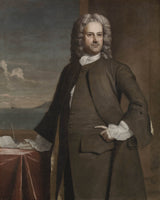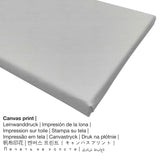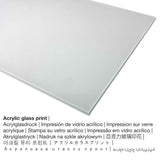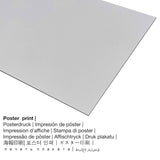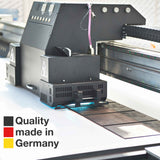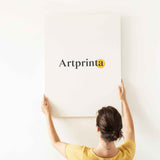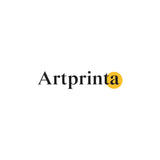Robert Feke, 1748 - Charles Apthorp - mbipụta nka mara mma
Ụtụ gụnyere. Mbupu gbakọrọ na ndenye ọpụpụ.
What does the website of the The Cleveland Museum of Art state about this 18th century artwork from the painter Robert Feke? (© - by The Cleveland Museum of Art - Velọ ihe ngosi nka nke Cleveland)
Called "the greatest merchant on this Continent" in his obituary, Apthorp helped transform Boston into one of the key commercial centers in the American colonies. When the fashionable painter Feke came to town, Apthorp commissioned this elegantly tailored and confidently posed likeness of himself. The sailing ship in the distant background symbolizes Apthorp’s deep financial interests in the Atlantic trade, which included not only products such as textiles, wine, and guns, but also human commodities in the form of slaves. In fact, the slave trade and its attendant commerce comprised a significant portion of colonial Boston’s economy until the decades after the Revolutionary War, when anti-slavery attitudes in New England gained momentum.
Ozi ndabere ọrụ nka
| Aha eserese: | "Charles Apthorp" |
| Nhazi nka: | sere |
| Okwu mkpokọta: | nka ochie |
| oge: | 18th narị afọ |
| Emepụtara na: | 1748 |
| Afọ nka: | ihe dị ka afọ 270 |
| Agba na: | mmanụ na kwaaji |
| Nha nke ihe nka izizi: | Nhazi: 141,5 x 117,5 x 7,5 cm (55 11/16 x 46 1/4 x 2 15/16 na); Emebereghị: 127 x 101,5 cm (50 x 39 15/16 na) |
| Akara mbinye aka: | signed lower right: R F P/174[8] |
| Ụlọ ihe ngosi nka / ebe: | Velọ ihe ngosi nka nke Cleveland |
| Ebe ngosi nka: | Cleveland, Ohio, United States nke America |
| website: | Velọ ihe ngosi nka nke Cleveland |
| Ụdị nka nka: | ngalaba ọha |
| Site n'aka: | Velọ ihe ngosi nka nke Cleveland |
| Ebe kredit nke ọrụ nka: | Onyinye nke John Huntington Art na Polytechnic Trust |
Ose okwu
| Aha onye nka: | Robert Feke |
| Aha utu aha: | Feke, Robert Feke, Feke Robert |
| Gender: | nwoke |
| Obodo onye nka: | American |
| Ọrụ onye na-ese ihe: | onye na-ese ihe |
| Obodo onye nka: | United States |
| nhazi ọkwa: | nna ukwu ochie |
| Nwụrụ anwụ: | 43 afọ |
| Amụrụ n'afọ: | 1708 |
| Amụrụ na (ebe): | Oyster Bay, Nassau County, New York steeti, Njikota Obodo Amerika |
| Nwụrụ n'afọ: | 1751 |
Nkọwa ngwaahịa ahaziri ahazi
| Bipụta ngwaahịa: | nka nka |
| Usoro mmeputakwa: | dijitalụ mmeputakwa |
| Production usoro: | Mbipụta UV ozugbo (mbipụta dijitalụ) |
| Mmalite nke ngwaahịa a: | arụpụtara na Germany |
| Stockdị ngwaahịa: | a na-achọ |
| A na-atụ aro iji ngwaahịa eme ihe: | ụlọ mmepụta ihe nka, foto mgbidi |
| Nhazi: | usoro eserese |
| Ụdị anya: | 1: 1.2 - ( Ogologo: obosara) |
| Ntụgharị asụsụ oke onyonyo: | ogologo bụ 20% mkpụmkpụ karịa obosara |
| Akụrụngwa ị nwere ike ịhọrọ site na: | Mpempe akwụkwọ, akwụkwọ mmado (akwụkwọ akpa), mbipụta enyo acrylic (nwere ezigbo mkpuchi iko), mbipụta ọla (aluminium dibbond) |
| Mbipụta kanvas (akwa akwa na etiti ihe ndọtị) dị iche iche: | 50x60cm - 20x24", 100x120cm - 39x47", 150x180cm - 59x71" |
| Acrylic glass print (nwere ezigbo mkpuchi iko) nhọrọ: | 50x60cm - 20x24", 100x120cm - 39x47", 150x180cm - 59x71" |
| Mpempe akwụkwọ mmado (akwụkwọ kwaaji) nha: | 50x60cm - 20x24", 100x120cm - 39x47" |
| Ụdị nha ebipụta aluminom: | 50x60cm - 20x24", 100x120cm - 39x47" |
| Nhazi nke nka nka: | adịghị |
Họrọ ngwa ngwaahịa ịchọrọ
Anyị na-enye ihe dị iche iche dị iche iche na nha maka ngwaahịa ọ bụla. Ya mere, anyị na-enye gị ohere ịhọrọ n'ime nhọrọ ndị a:
- Mbipụta iko acrylic (nke nwere ezigbo mkpuchi iko): An acrylic glass print, which is sometimes labelled as a plexiglass print, will convert your original into beautiful décor. Your favorite work of art is being manufactured with state-of-the-art UV direct printing technology. This creates vivid and sharp color tones. With an acrylic glass fine art print contrasts plus minor image details become identifiable thanks to the fine gradation.
- Mbipụta akwụkwọ mmado (ihe kwaaji): A poster is a UV printed flat cotton canvas paper with a nice structure on the surface, that resembles the actual work of art. A poster print is ideally qualified for putting the art print with a custom-made frame. Please note, that depending on the absolute size of the poster print we add a white margin of approximately 2-6cm around the print motif to facilitate the framing with your custom frame.
- Mbipụta kanvas: A UV printed canvas stretched on a wood stretcher frame. A canvas produces the extra effect of three dimensionality. A canvas print has the advantage of being low in weight. This means, it is easy to hang the Canvas print without the support of additional wall-mounts. Because of thatcanvas prints are suited for any type of wall.
- Aluminom ihe eji eme ihe: These are metal prints on aluminium dibond material with an outstanding depth effect. Its non-reflective surface structure make a contemporary impression. A direct Aluminium Dibond Print is your perfect introduction to reproductions with aluminum. For your Print On Aluminum Dibond, we print the chosen work of art onto the surface of the white-primed aluminum. The bright and white parts of the work of art shimmer with a silky gloss, however without glow. The colors are bright and vivid, fine details are very clear, and the print has a a matte appearance you can literally feel. This direct UV print on aluminium is the most popular entry-level product and is an extremely modern way to display artworks, because it draws focus on the artwork.
Product nkọwa
The nka ochie painting was painted by the painter Robert Feke. The original was made with the size - Nhazi: 141,5 x 117,5 x 7,5 cm (55 11/16 x 46 1/4 x 2 15/16 na); Emebereghị: 127 x 101,5 cm (50 x 39 15/16 na) ewe tee ya n'etiti manu ahu n'elu kwaaji. Ihe osise a nwere ederede dị ka ndetu: signed lower right: R F P/174[8]. N'ịga n'ihu, enwere ike ịhụ ihe osise a n'ime Ụlọ ihe ngosi nka nke Cleveland digital art collection. With courtesy of: The Cleveland Museum of Art (ikikere: ngalaba ọha). Ebe kredit nke ọrụ nka: Onyinye nke John Huntington Art na Polytechnic Trust. Besides this, the alignment is portrait and has an image ratio of 1: 1.2, nke pụtara na ogologo bụ 20% mkpụmkpụ karịa obosara.
Nkwupụta iwu: We do to depict the art products as accurate as it is possible and to showcase them visually in our shop. Nonetheless, the colors of the print products and the imprint can diverge to a certain extent from the presentation on the device's monitor. Depending on your settings of your screen and the nature of the surface, not all colors can be printed one hundret percent realistically. Because all the are printed and processed manually, there might also be minor deviations in the exact position and the size of the motif.
© nwebiisinka site na - Artprinta.com

